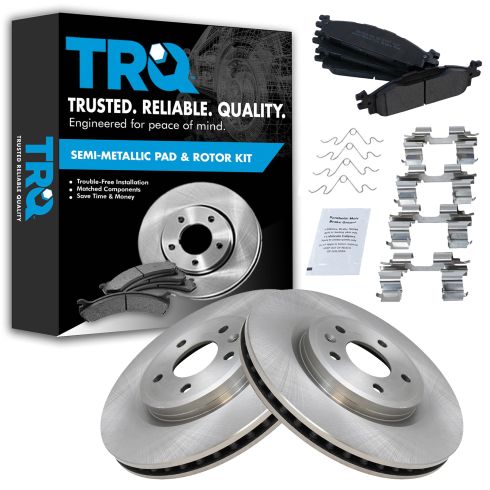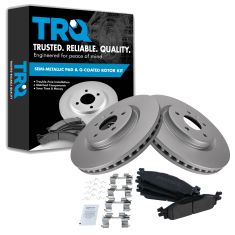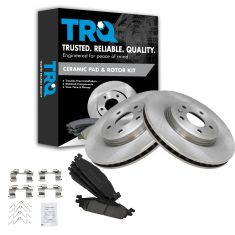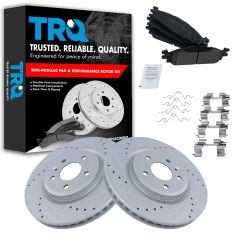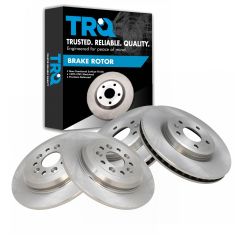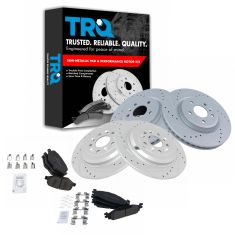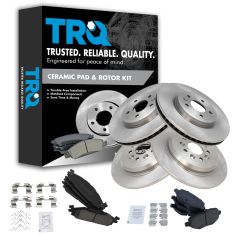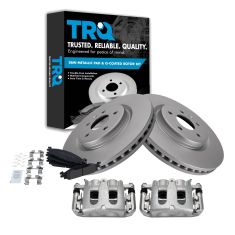Hi, I'm Mike from 1A Auto. We've been selling auto parts for over thirty years. We're dedicated to delivering quality auto parts, expert customer service, fast and free shipping, all backed by our 100% satisfaction guarantee. We've created thousands of videos to help you install our parts with confidence. That saves you time and money, so visit us at 1AAuto.com, your trusted source for quality auto parts.
In this video, we're going to be working with our 2006 Ford Explorer. We're going to show you how to remove and replace your front brake pads and rotors. If you like this video, please click subscribe. We have a ton more information on this truck as well as many other makes and models. If you need these parts for your vehicle, you can follow the link down in the description over to 1AAuto.com.Here are the items you'll need for this repair.
Using a 19mm socket and a breaker bar, loosen the lug nuts. Your vehicle should have five, but ours has a stud broken off. We're using a lift to make it easier to show you what's going on, but this job can easily be done in the driveway on a jack and jack stand. With the vehicle raised and supported, go ahead and finish removing your lug nuts. Remove your wheel and tire.
On the back side of the caliper, remove the two 17mm bolts securing the caliper onto the slides of the bracket. We'll do this using the 17mm socket and a ratchet. Be sure to loosen both of them before removing either one, fully, to prevent the caliper from twisting on the slide when you go to remove a stuck bolt. With the bolts removed, work the caliper off of the pads and out of the bracket. You may need a small pry bar to help get the caliper off of the bracket. This particular vehicle has been sitting for a few years, so everything's pretty well stuck on there. Using a bungee cord, mechanics wire, or a zip tie, whatever you have handy, we'll remove the caliper and hang it up out of the way. This way we know it won't fall and tear the flex hoses.
On the backside of the caliper bracket, we'll remove the two bolts with a 21mm socket. We're going to start it with a breaker bar and then move to a ratchet. The same rule applies here, where you'll want to break both of them lose before removing either one fully, so we don't twist that bracket while we're removing the bolts. Remove the bracket from the vehicle. Remove the rotor from the hub.
Whenever you're working on brake components, we recommend you wear a dust mask just to keep all of this brake dust from getting into your lungs. Once you've got your caliper bracket off, go ahead and tap the pads out. Carefully pop the clips off. If these are really rusted and corroded, you're going to have to replace them, but ours don't look too bad. We'll just clean them up. The same process will apply whether you're reinstalling a good set of old slides or replacing them with a new one. Using a wire brush or a wire wheel, if you have one, go ahead and get all of that build-up and debris out of the area underneath the slides. If your clips look good but just have a little bit of dirt build up on them, you can go ahead and clean them off the same way with that wire brush. Now, these don't have to be absolutely perfect, but you want to make sure that you get any heavy deposits and build ups off of there to make sure that your brakes slide smoothly.
Reinstall your clips once your bracket and clips are clean. Then, we'll apply a thin coat of brake grease to where the pads are going to ride on the slides. There's no need to really build up a thick coat of grease here as long as we get a nice coat on there. Get that metal covered. It will keep it from corroding, quiet our brakes down, and give a nice quiet, smooth operation.
Peel back the boots on your caliper slides. Remove the slides one at a time. Use a paper towel or a rag to wipe off all that old grease. Then, we'll apply a new coat with the same brake grease we used on the slides. The one we're using here happens to be gray, but they also make clear ones. There's kind of a yellowish one. Doesn't really matter as long as you're using a brake specific grease, because non-brake greases can cause wear on these components. If it gets onto a rotor or pad, it's going to do a lot more damage than this stuff would. Slide that back in until the boot reattaches. You can see how much smoother that slide moves now compared to our old one. Go ahead and repeat that step with the other slide. Now, we're ready to reinstall our caliper bracket onto the vehicle.
Here we have our old brake parts that we removed from our vehicle and our new parts from 1AAuto.com. As you can see, these parts are exactly the same. We have the same dimensions on our pads here. You can sort of tell where the breather channel was in the middle of these pads before they got worn down. These pads aren't completely worn out. We probably still have five thousand miles or so on there. You can see the difference between the old pad and the new pad as far as the thickness of the material. The rotors are the exact same size and shape. There's are a little bit thicker, because our old parts have been used and worn down. You can see we have quite a bit of corrosion on here from them sitting, as well as being a properly vented rotor to allow the heat generated when braking to escape normally. If your vehicle has corroded brake parts that are making noise, not stopping properly, or they've just worn out from normal usage, these new parts from 1A Auto are going to go in direct fit, just like your original equipment, get your vehicle stopping smoothly and safely, and fix you up right.
Using a wire brush, we'll remove all of this rust build up and corrosion on the surface of the hub to make sure our rotor sits flat. Make sure you get the center bore here as well. Now that we've got all the rust and corrosion removed from our hub, we got ahead and put a nice coat of grease on there to keep any more corrosion from coming back and to make sure that our rotor is nice and easy to remove the next time we have to do a brake job. Again, there's no need to get really thick with the grease here. Just make sure that you cover all the metal surfaces that are going to contact our rotor. Install the rotor onto the splines backwards and spray down the contact surface with some brake cleaner.
Flip the rotor around, and install it back onto the splines in the correct direction, and spray down this surface the same way. We're doing this to remove cosmoline, which is a coating they put on to these rotors at the factory to prevent it from corroding while it sits on the shelf at a warehouse. The next step isn't completely necessary to finish the brake job, but if you have one handy it's really helpful and makes reinstalling the pads, caliper, and caliper bracket a lot easier.
We're going to use an old axle nut over one of the studs as a spacer. Just install one lug nut on there finger tight to keep our rotor flat against the hub, so when we reinstall the bracket, pads, and caliper, the rotor is nice and straight, and flush, and lines up with everything going on.
Reinstall your caliper bracket, and the two 21mm bolts that secure it to the spindle. We'll get those bolts started by hand, and then tighten them down with our socket and ratchet. Once they're in there by hand, go ahead and tighten them down with a 21mm socket and ratchet. Install the brake pads into the slides on the front and the rear. We'll apply another thin coat of grease to the back side of the pad here. This will prevent our caliper from getting stuck on. It'll also act as a little bit of an insulator to keep them from making move while they're moving.
Remove the bungee cord, mechanic's wires, zip tie, or whatever it is you used to secure the caliper up and out of the way. Be sure that when placing it back in that you don't have this flex hose, here, twisted up. Set the caliper back onto the slides, and reinstall the two bolts. You may have to work these around a little before the go in. Tighten the two caliper slide bolts up with a 17mm socket and ratchet. Remove the lug nut and the axle nut you used to keep that rotor in place.
Then we can reinstall our wheel and tire. Reinstall the wheel and tire onto your hub. It's easiest to put a lug nut inside of the 19mm socket to start it onto the studs. Get all five of these down as tight as you can by hand, and then we'll torque the wheel once there's some weight on it. Lower the vehicle back down, and put partial weight onto the wheel and tire. This means that you may have your jack or lift under the vehicle, get the tire to touch, and let the vehicle come downs some without allowing it completely off of the lift or jack. Torque your lug nuts to 100 foot-pounds in a cross pattern.
Thanks for watching. Visit us at 1AAuto.com for quality auto parts, fast and free shipping, and the best customer service in the industry.
